
Uvedba ukazov Ruby
1. Kaj je Ruby?
Ruby je odprtokodni programski jezik. Razlaga se tako kot objektno usmerjena. Ruby je ustvaril Yukihiro Matsumoto. Ruby je poimenovana po dragulju in zato jo je ustvarjalec povezal kot dragulj programskih jezikov. tukaj bomo razpravljali o različnih vrstah ukazov Ruby.
Oblika Rubyja upošteva naslednje dejavnike - Enostavnost, obsežnost, popolnost in prenosljivost. Ruby deluje na večini platform UNIX. Večji del Ruby je zgrajen na Linuxu. Ruby deluje tudi na običajnih platformah, kot so Windows, DOS, Mac itd.
B asic Ruby ukazi
1. Enostaven ukaz za tiskanje niza v Ruby
#!/usr/bin/ruby –w
puts “Hello, Ruby!”
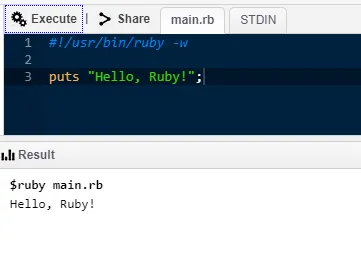
2. Enostaven ukaz za tiskanje več vrstic z EOF
#!/usr/bin/ruby –w
print < Multiple line string.
First wayEOF
print <<"EOF"; # same as above
Multiple line string.
Second way
EOF#!/usr/bin/ruby –w
print < Multiple line string.
First wayEOF
print <<"EOF"; # same as above
Multiple line string.
Second way
EOF
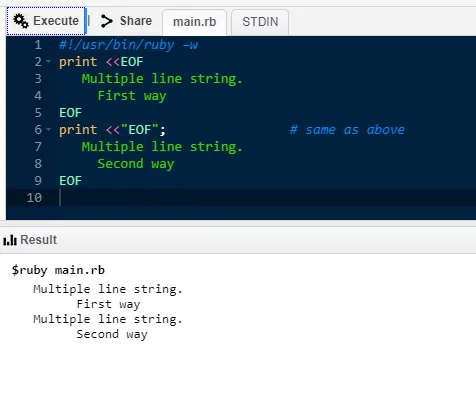
3. Preprost ukaz za tiskanje več vrstic z uporabo izvajanja ukaza
#!/usr/bin/ruby –w
print <<`EOC` # execute commands
echo First Statement
echo Second Statement
EOC

4. Enostaven ukaz za tiskanje več vrstic z zlaganjem.
#!/usr/bin/ruby –w
print <<"a", <<"b" # you can stack them
I said foo.
a
I said bar.
b

5. Stavka Ruby BEGIN
#!/usr/bin/ruby
puts "This statement comes later"
BEGIN (
puts "This statement will be printed in the beginning"
)

6. Stavek Ruby END
#!/usr/bin/ruby
puts "This is main body"
END (
puts "This block executes in the end"
)
BEGIN (
puts "This block executes in the beginning"
)

7. Komentiraj eno vrstico Ruby
#!/usr/bin/ruby
# This is a single line comment.
uts "This is not a comment" # This is again a single line
comment.
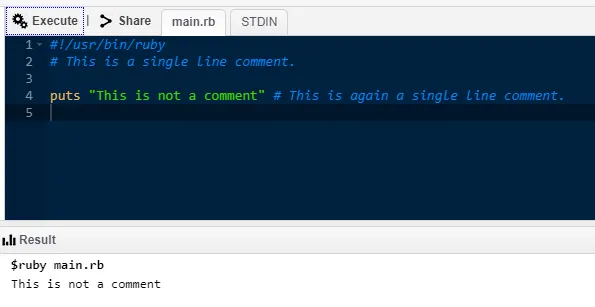
8. Komentirajte več vrstic
#!/usr/bin/ruby=begin
This is a multiple line comment.=end
puts "This is not a comment" # This is a single line comment.

9. Funkcija člana v razredu Ruby Ustvarjanje predmeta in klicanje metode.
#!/usr/bin/ruby
class Demo
def testmethod
puts "Hello World!"
end
end
# Now using above class to create objects
object = Demo.new
object.testmethod

10. Globalne spremenljivke v Rubyju
#!/usr/bin/ruby
$globalvariable=123
class FirstClass
def printglobal
puts "Global variable in FirstClass is #$globalvariable"
end
end
class SecondClass
def printglobal
puts "Global variable in SecondClass is #$globalvariable
end
end
class1obj = FirstClass.new
class1obj.printglobal
class2obj = SecondClass.new
class2obj.printglobal
Vmesni ukazi
1. ČE… ELSE v Rubyju
#!/usr/bin/ruby
x = 1
if x > 2
puts "x is greater than 2"
elsif x <= 2 and x!=0
puts "x is 1"
else
puts "I can't guess the number"
end

2. Primer v Rubyju
<#!/usr/bin/ruby
$age = 17
case $age
when 0 .. 17
puts "Not eligible to vote"
when > 17
puts "Eligible to vote"
else
puts "incorrect age"
end
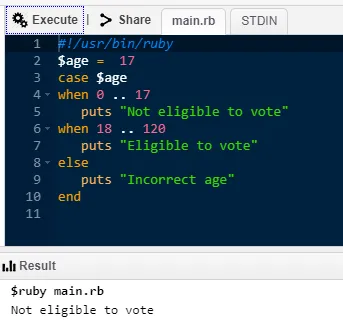
3. Zanke v Ruby
- 3.1. Medtem ko zanka
#!/usr/bin/ruby
$i = 0
$num = 10
while $i <
$num do
puts("Inside the loop i = #$i" )
$i = $i + 1
end
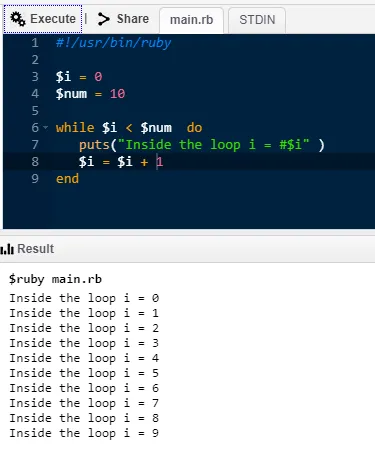
- 3.2. Dokler zanke
#!/usr/bin/ruby
$i = 0
$num = 4
until $i > $num do
puts("Inside the loop i = #$i" )
$i = $i + 1;
end

- 3.3. Za zanko
#!/usr/bin/ruby
for i in 0..9
puts "Local variable value is #(i)"
end
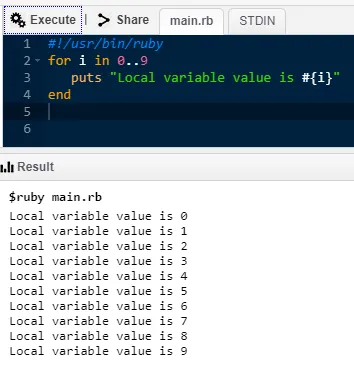
- 3.4. Izjava o prekinitvi
#!/usr/bin/ruby
for i in 0..5
if i > 3 then
break
end puts "Local variable is #(i)"
end

- 3.5. Naslednja izjava
#!/usr/bin/ruby
for i in 0..10
if i < 6 then
next
end
puts "Local variable is #(i)"
end
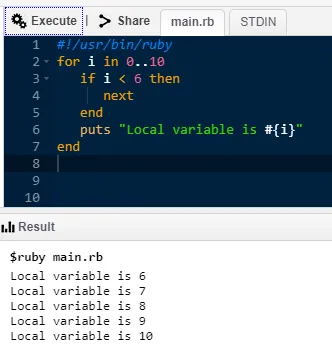
4. Skladnja metode v Rubyju
#!/usr/bin/ruby
def test(a1 = "Noodles", a2 = "Pasta")
puts "The food is #(a1)"
puts "The food is #(a2)"
end
test "Burger", "Pizza"
test

5. Izjava o vračilu v Ruby
#!/usr/bin/ruby
def testreturn
a = 10
b = 20
c = 30
return a, b, c
endvar1 = testreturn
puts var1
6. Parametrizirana metoda v Rubyju
#!/usr/bin/ruby
def sample (*testparam)
puts "The number of parameters are #( testparam.length)"
for i in 0… testparam.length
puts "The parameters are #(testparam(i))"
end
end
sample "Hello", "123", "ABC", "Programming"
sample "World", "456", "Ruby"
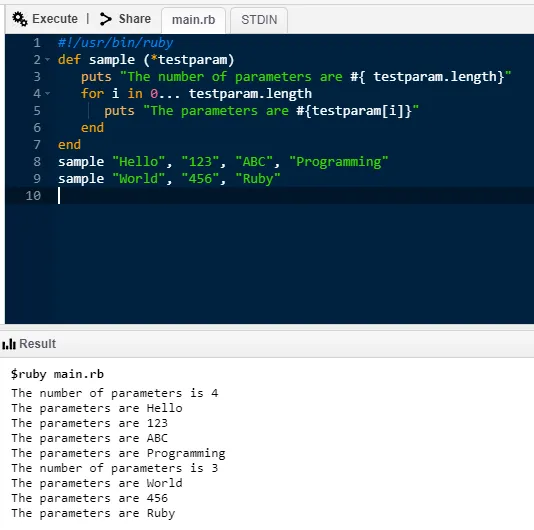
7. Izvedbeni blok z uporabo izjave o donosu
#!/usr/bin/ruby
def test
yield
end
test( puts "Hello world")

8. Bloki BEGIN in END v Rubyju
#!/usr/bin/ruby
BEGIN ( # BEGIN block code
puts "BEGIN code block"
)
END (
# END block code
puts "END code block"
)
# MAIN block code
puts "MAIN code block"

9. String Expression Substitution v Rubyju
#!/usr/bin/ruby
a, b, c = 1, 2, 3
puts "The value of a is #( a )."
puts "The sum of b and c is #( b + c )."
puts "The average is #( (a + b + c)/3 )."

10. Ustvarjanje matrike v Rubyju
#!/usr/bin/ruby
names = Array.new(10)
puts names.size # returns 10
puts names.length # returns 10
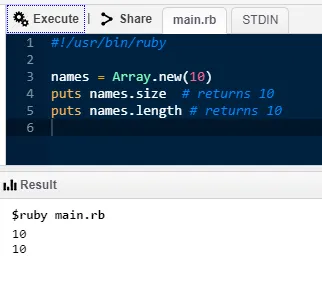
Napredni ukazi Ruby
1. Metode Getter in Setter v Rubyju
#!/usr/bin/ruby -w
# defining a class
class Box
# constructor method
def initialize(l, b, h)
@length, @width, @height = l, b, h
end
# accessor methods
def printLength
@length
end
def printBreadth
@breadth
end
def printHeight
@height
end
end
# create
an object
box = Box.new(10, 30, 40)
# use accessor methods
l = box.printLength()
b = box.printBreadth()
h = box.printHeight()
puts "Box Length : #(l)"
puts "Box Breadth : #(b)"
puts “Box Height : #(h)”

2. Pisanje običajnih skript vmesnika za prehod s pomočjo Rubyja
#!/usr/bin/ruby "
require 'cgi'
cgi = CGI.new
puts cgi.header
puts "This is a test
3. Programiranje vtičnic z uporabo Rubyja
- 3.1. Preprost primer strežnika, ki uporablja Ruby
require 'socket' # Get sockets from stdlib
server = TCPServer.open(8090) # listen on port 8090
loop ( # Running the server infinitely
client = server.accept # Connecting client wait time
client.puts(Time.now.ctime) # send time to client
client.puts "Closing the connection!"
client.close # Client disconnect
)
- 3.2. Preprost primer stranke, ki uporablja Ruby
require 'socket' # Get socket from stdlib
hostname = 'localhost' # Set hostname
port = 8090 # Set portsock = TCPSocket.open(hostname, port)
while line = sock.gets # Read lines from the socket
puts line.chop # print with platform line terminator
end
sock.close # Socket closing
4. Multithreading primer v Ruby
#!/usr/bin/ruby
def function1
i = 0
while i<=2
puts "function1 at: #(Time.now)"
sleep(2) i = i+1
end
end
def function2
j = 0
while j<=2
puts "function2 at: #(Time.now)"
sleep(1)
j = j+1
end
end
puts "Started At #(Time.now)"
t1 = Thread.new(function1())
t2 = Thread.new(function2())
t1.join
t2.join
puts "End at #(Time.now)"
Nasveti in nasveti za uporabo ukazov Ruby
Ker delo v katerem koli programskem jeziku zahteva znanje in pripravljenost za nadgradnjo, tudi ta primer ni izjema. Uporaba osnovnih ukazov ter vadba in obvladovanje ukazov je ključ za obvladovanje tega lepega jezika.
Zaključek - Ukazi Ruby
Ukaz Ruby je brezplačni in odprtokodni programski jezik; je prilagodljiv in je bogat z značilnostmi. Kot že ime pove, je rubin resnično dragulj, ki je zelo poceni. Zaradi svoje funkcije plug and play in tudi enostavno berljive skladnje je zelo uporabniku prijazen. Njegova napredna scenaristična naprava tudi povzema svojo priljubljenost.
Priporočeni članki
To je vodnik za ukaze Ruby. Tu smo razpravljali o osnovnih ukazih Ruby in nekaterih vnaprejšnjih ukazih Ruby. Če želite izvedeti več, si oglejte tudi naslednji članek.
- Kako uporabljati ukaze selena?
- Najbolj iskreni ukazi
- Ukazi HBase
- Kako uporabljati ukaze Tableau?
- Programiranje vtičnic v Pythonu